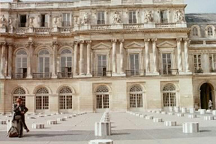
How you gonna keep 'em down on the farm...?
June 25, 2000
Copyright 2000 Douglas E. Welch
Friend-LINK: <%=INSERTTEXT%>

A Gardener's Notebook:
The latest incarnation of my column detailing the trails and tribulations
of my garden. Join the list and ask your own questions about gardening
Subscribe
Gardens are grown throughout the world and Europe has a long history of them; from the ancient people growing medicinal herbs and food, through Vita Sackville-West’s White Garden, right up to the replanting of storm-damaged trees at Versailles after the cruelest of winters in 1999. Continuing our travelogue of the gardens of Europe, we move on to Paris via the Eurostar train and the channel tunnel (or Chunnel, as it is called by most folks.)
The Eurostar leaves Waterloo station just across the Thames from the City of London. After a complimentary glass of champagne and a look at some typical rail-side architecture we emerged, quite soon, in the English countryside.
The verdant greens amaze, especially after living in Southern California for the past 14 years. I am used to the muted greens of our hillsides that slowly turn golden as they bake in the summer sun. In England, the green is nearly overwhelming. Stone fences and stands of trees mark out pastures, hay fields and other crops. We spy sheep and cattle grazing and watch the everyday work of farmers as the train rolls on. After having spent an entire week in the midst of the city I was heartened to see the open-spaces again.
The time actually spent in the Channel Tunnel is a relatively short 20 minutes or so. It is a bit odd to realize that you are in a different country when you suddenly emerge on the other side of the English Channel near Calais. Even more striking is the similarity of the countryside. Only 26+ miles separates the British Isles from Normandy so the flora remains much the same.
As I noticed throughout Europe, the concept of order vs. nature is carried out even into the countryside. Well tended fields and fences abut fence-rows of trees left to grow as they may. It looks as if some farmers utilize these fence-rows and larger wood-lots much in the same way as American farmers; providing a bit of firewood for the winter.
Too soon for my liking we began to enter the city and arrived at Gare du Nord, one of the train stations very near the center of Paris.
 Order, order, order
Order, order, orderOur hotel, Hotel de Louvre, was positioned right next to the Louvre itself and gave us easy access to the usual tourist attractions and several wonderful gardens. Just across the street, enclosed in courtyard of buildings formerly owned by the nobility, sits the Palais Royale. This garden had something for everyone. The south end contained a paved, modernistic landscape of pillars and an underground stream.
Continuing to the north, beyond a more traditional colonnade stood long rows of tidy ficus trees, carving out several long, shade-filled alleys. Down the center of the garden stood several smaller flower gardens with fountains and benches. Well-trimmed hedges and planting beds dominated throughout the garden. The long, straight and wide pathways were paved simply in gravel. Even though my son, Joseph, took several tumbles in the gravel during our many visits to the garden, this place seemed to be his favorite.
The gardens were also used as an outdoor art gallery. There were many works by both well known and lesser-known artists. In this photo you will notice a Botero sculpture in the foreground.
We also spent time in the Tuileries Gardens, which run along the Seine from the Louvre to the Place de la Concorde. Again, order reined supreme throughout. The Tuileries included grand fountains, large expanses of grass, and meticulously arranged flowerbeds. Of course, they also had waiter service at their park snack bars, so there just might be something good about all this order.
Along the Seine were planted trees that looked like cottonwoods. They moved beautifully in the breeze that always seemed to be moving near the river. The rest of the riverside is simply paved with stone and no other plantings.
 As in any large city, people will find a way to garden no matter
where they might be living. As I emerged from the hotel one afternoon
a splash of red caught my eye high atop one of the buildings surrounding
the square. On the balcony of an apartment on the uppermost floor
stood a window box of geraniums or roses almost glowing in the
sunshine. There is an inborn desire to garden, even if you have
to do it 40 feet in the air.
As in any large city, people will find a way to garden no matter
where they might be living. As I emerged from the hotel one afternoon
a splash of red caught my eye high atop one of the buildings surrounding
the square. On the balcony of an apartment on the uppermost floor
stood a window box of geraniums or roses almost glowing in the
sunshine. There is an inborn desire to garden, even if you have
to do it 40 feet in the air.
Next week I take on the gardens of Rome and Sicily.
Douglas E. Welch is a freelance writer and computer consultant
based in Van Nuys, California.
He can be reached at douglas@welchwrite.com or via his web pages at www.welchwrite.com.
<%=INSERTTEXT%>
|
<%=INSERTTEXT%> |